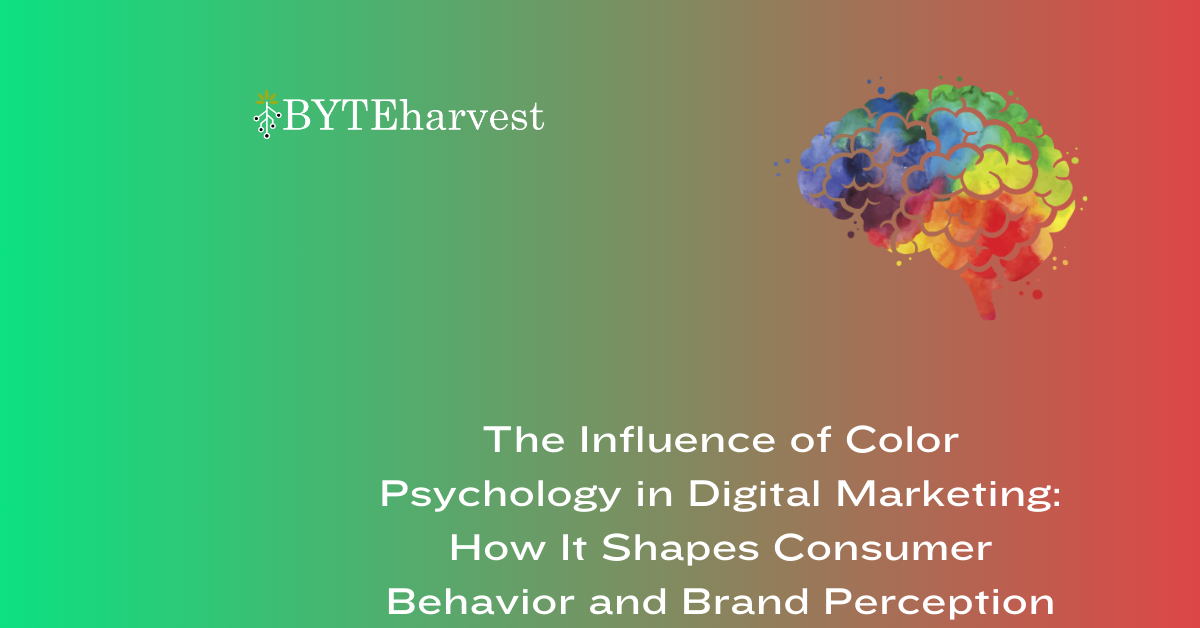The Power of Color Psychology in Digital Marketing: How Brands Influence Consumer Behavior
Color psychology plays a big role in shaping consumer behavior, making it an essential aspect of digital marketing and branding. The colors you choose can influence emotions, affect consumer decisions, and even drive conversions. Understanding color psychology in marketing allows businesses to use color strategically to build brand identity and create effective marketing strategies. This article explores how brands can use the power of color to shape consumer perceptions and engagement.

Outline:
- What is Color Psychology and How Does It Influence Consumer Behavior?
- Why Brands Should Pay Attention to Color Psychology in Marketing
- How Different Colors Evoke Emotions and Influence Consumer Behavior
- Choosing the Right Color for Your Brand Identity
- The Role of Color in Marketing Strategies
- Understanding the Impact of Color on Digital Marketing
- How Marketers Use Color to Enhance Conversion Rates
- Common Color Associations in Branding and Advertising
- The Role of the Color Wheel in Selecting Colors
- How to Use Color Psychology for Effective Call-to-Action Buttons
1. What is Color Psychology and How Does It Influence Consumer Behavior?
Color psychology refers to the study of how colors influence emotions, perceptions, and behaviors. In marketing and branding, different colors evoke specific emotional responses, shaping how consumers interact with brands. Understanding color psychology helps marketers create more engaging campaigns and influence consumer behavior strategically.
2. Why Brands Should Pay Attention to Color Psychology in Marketing
Color psychology in digital marketing is essential because it affects brand recognition, brand awareness, and consumer engagement. The right color choices can help brands establish trust, build credibility, and create a lasting impression. Marketers must use color psychology strategically to align their brand’s values with their target audience’s perceptions.
3. How Different Colors Evoke Emotions and Influence Consumer Behavior
Different colors evoke specific emotions. For example, warm colors like red and yellow create a sense of urgency, while cool colors like blue and green convey calmness and trust. Brands can use color psychology to shape consumer perceptions and create marketing strategies that resonate with their audience.
4. Choosing the Right Color for Your Brand Identity
Choosing the right color is crucial for brand identity. Certain colors help establish a brand’s image and values. A marketer must consider personal preferences, cultural associations, and the psychological effects of colors when selecting the best colors for their brand. Consistent color use strengthens brand recognition and enhances marketing efforts.
5. The Role of Color in Marketing Strategies
Marketing and branding efforts rely on strategic color choices to attract consumers. The colors used in marketing campaigns should align with a brand’s identity and messaging. Understanding color psychology allows businesses to optimize their branding and advertising strategies for maximum impact.
6. Understanding the Impact of Color on Digital Marketing
In today’s digital information world, color plays a big role in capturing attention and driving engagement. Marketers must consider the color spectrum, contrasting colors, and color combinations to create visually appealing designs. Digital marketing success often depends on the effective use of color to enhance brand visibility and influence consumer behavior.
7. How Marketers Use Color to Enhance Conversion Rates
Marketers use color to influence consumer decisions and improve conversion rates. Call-to-action buttons, for example, should use contrasting colors to stand out. The use of red can create a sense of urgency, while blue and green can build trust. Understanding color psychology in marketing helps businesses optimize their marketing strategies for higher conversions.
8. Common Color Associations in Branding and Advertising
Brands can use color associations to evoke specific emotions in their consumers. For example, red is associated with excitement and urgency, while blue signifies trust and reliability. The best colors for a brand depend on the emotions they want to evoke and their industry’s color preferences.
9. The Role of the Color Wheel in Selecting Colors
The color wheel helps marketers choose colors that complement each other. Selecting colors strategically can create a cohesive brand image and improve consumer engagement. Marketers should use the color wheel to explore color schemes, contrasting colors, and harmonious color combinations for their branding efforts.
10. How to Use Color Psychology for Effective Call-to-Action Buttons
Call-to-action buttons should be designed using strategic color choices. The colors can influence click-through rates and engagement. Using bright colors or high-contrast color combinations ensures visibility and effectiveness. Marketers should consider the psychology of color when optimizing their call-to-action elements.
Key Takeaways:
- Color psychology influences consumer behavior and brand perception.
- Choosing the right color is essential for building brand identity.
- Different colors evoke specific emotions and responses.
- Marketers should strategically use colors in branding and advertising.
- The color wheel helps brands select effective color combinations.
- Call-to-action buttons should use contrasting colors to enhance conversions.
Understanding color psychology is crucial for brands looking to enhance their marketing efforts and consumer engagement. By leveraging the power of color, businesses can shape consumer perceptions, influence consumer behavior, and optimize their branding and digital marketing strategies.

